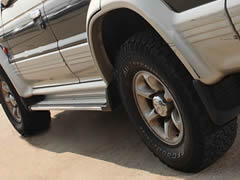Understanding Wheel Alignment - Vol.136
Unless you are a certified mechanic, the most you probably know about vehicle suspension systems and wheel alignment is from personal experience after hitting a pot hole while driving your car. You may notice that after a particularly hard hit, your car tends to pull to the right or the left. This is because your car is no longer aligned. To better understand this, you will need to know about the vehicle suspension system and its relationship to wheel alignment.

Suspension System
Proper wheel alignment is closely connected to a car's suspension system. Part of the suspension system involves the linkage of the car to the wheels. Wheels need to be able to rotate so that the car also turns without placing unnecessary pressure on the various parts concerned. When the suspension system is damaged, it can influence wheel alignment and vice versa. If the shock absorbers and springs do not work properly on the suspension, it is possible for the wheels to be out of alignment. And this is potentially dangerous since you have less control over the vehicle at that point.
Wheel Alignment
This is basically the angle of wheels in relation to the entire car. You know your car has proper wheel alignment when your car drives straight while you have the steering wheel in a straight position. If your steering wheel is straight but you appear to be moving toward the right or left, your wheel alignment is off. Each vehicle has its own alignment specifications. You can find out what yours are by checking your car owner's manual.
Signs Wheels are Out of Alignment
In addition to pulling to the right or left as mentioned above, there are additional signs you may need a wheel alignment adjustment. A common one is tire wear. With proper wheel alignment, your tires will wear evenly. But when your alignment is out, you will notice that one or two tires are wearing differently than the other ones. Once your alignment is corrected, your mechanic will rotate the tires so they can begin to wear evenly again. Another sign that many drivers do not immediately associate with wheel alignment is wandering. Unlike an obvious pull, you might find that your car is simply unable to drive in a straight line but wanders back and forth instead.
Adjusting Wheel Alignment
Most drivers cannot align their own vehicles. You will need to take your car to a certified mechanic to have this work done. The mechanic is able to look up the specifications for your car so the resulting wheel alignment is correct. Specifications include three distinct measurements: toe, camber, and caster. A problem with the toe measurement typically means that your vehicle will drag its tires sideways because the wheels are either turned inward or outward too much. Tire dragging causes your engine to work hard and use more fuel. A camber is when the top of the wheels bulge outwards or lean inwards. Camber problems typically arise when wheel parts become worn. The caster is specific to the steering pivot point which makes the car wander too much or even pull in a specific direction.
Final Thoughts
It is not unusual for car owners to continue to drive even once they suspect they have an alignment issue. The problem with that is you risk further damage to your suspension system or even losing complete control over your vehicle while driving. As soon as you believe your wheel alignment is out or experience any of the situations described above, you should get your vehicle looked at by a certified mechanic who can realign your wheels and fix any related problems to your suspension.